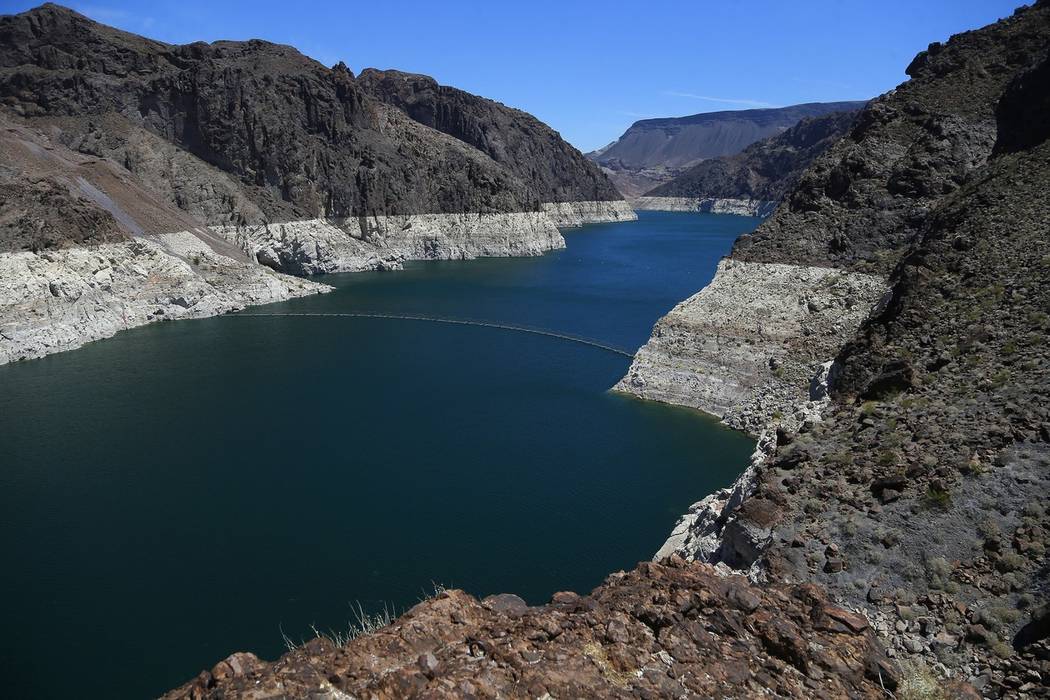Colorado River states OK tentative plan to slow reservoirs’ decline

Officials in the seven Western states that share the shrinking Colorado River have reached a tentative agreement on plans aimed at slowing the decline of the river’s two largest reservoirs.
The U.S. Bureau of Reclamation released drafts of the plans Tuesday and Wednesday, as the various state and federal stakeholders work toward final approval of their sweeping response to almost 20 years of drought on the river.
Under the broader deal, Colorado, New Mexico, Utah and Wyoming would send more water downstream to prop up Lake Powell, while Nevada, Arizona and eventually California would cut their river use to keep more water in Lake Mead.
Nevada has been waiting to sign its parts of the plan since 2016, but the agreement has been held up internal talks among water users in Arizona and California over how to share the voluntary reductions in water use.
Southern Nevada Water Authority General Manager John Entsminger said he expects to be able to present the planning documents to the agency’s board for approval at its Nov. 15 meeting — something he considers a major development after three years of negotiations.
“This is far enough along and the states are optimistic enough about getting it across the finish line that they feel comfortable to take the documents public,” he said. “I take that as a very good sign.”
In a joint statement Wednesday, the Bureau of Reclamation’s top two officials on the river, Lower Colorado Regional Director Terry Fulp and Upper Colorado Regional Director Brent Rhees, praised what they called “an important step forward” by the states.
“We are encouraged by their progress in responding to ongoing drought conditions that continue to threaten reservoir elevations at an unprecedented rate,” Fulp and Rhees said. “We encourage the states to finalize their draft agreements by December 2018 to ensure the sustainability of the Colorado River system.”
The collection of drought contingency plans are designed to protect hydroelectric power generation at Lake Powell’s Glen Canyon Dam and slow the descent of Lake Mead by reducing water use beyond the mandatory cuts that would be imposed in the event of a federal shortage declaration.
Shortage declaration expected
That first-ever declaration now appears likely in early 2020, based on the Bureau of Reclamation’s latest projections for reservoir east of Las Vegas.
A federal shortage would initially require Arizona to cut its annual river use by 320,000 acre-feet while Nevada would take a 13,000-acre-foot cut.
Under the first round of voluntary drought contingency cuts, Nevada would leave 8,000 acre-feet of water in Lake Mead and Arizona would forgo 192,000 of its 2.8 million acre-foot river allocation.
Any voluntary cuts would come on top of the escalating series of mandatory shortages Nevada and Arizona will have to absorb should the surface of the lake drop below certain trigger points outlined in a 2007 agreement among the states.
California doesn’t face any mandatory cuts to its 4.4 million acre-foot river allocation, which is the largest among the seven Colorado River states, but officials in the Golden State have tentatively agreed to voluntary drought contingency cuts starting at 200,000 acre-feet a year should the surface of Lake Mead drop another 35 feet.
One acre-foot is enough to supply two average homes for just over one year.
Nevada’s annual river allocation of 300,000 acre-feet is the smallest among the seven states. Nearly all of that water goes to the Las Vegas Valley, which relies on Lake Mead for 90 percent of its supply.
The community has already saved more than enough water through conservation to absorb the potential voluntary and mandatory cuts to its river allocation, according to Entsminger. He said the largest reduction the authority faces in a given year is 30,000 acre-feet, which is “within our pain tolerance.”
In addition to the “certainty” they get from the new drought planning, Entsminger said the deal lifts restrictions on some of the water the authority has “banked” over the years, allowing those resources to be tapped at any time, regardless of conditions on the river.
Lake Mead 38 percent full
The Colorado just saw its 14th year of below-average flows since 1999, leaving Lake Mead at 38 percent of capacity and Lake Powell at 45 percent capacity.
Drought has only exacerbated the man-made “structural deficit” on the Colorado and its tributaries, where users are legally entitled to more water than the river actually carries as a result of outsized allocations parceled out almost 100 years ago.
That’s why collaborative efforts like this are so important to long-term water security across the Southwest, said Taylor Hawes, Colorado River program director for The Nature Conservancy.
“We are facing evolving challenges in the basin as temperatures increase, precipitation declines and more people move to the region,” Hawes said in a written statement. “We must keep our foot on the pedal to ensure we can develop the solutions we need ahead of a more serious crisis.”
Contact Henry Brean at hbrean@reviewjournal.com or 702-383-0350. Follow @RefriedBrean on Twitter.
The Associated Press contributed to this report.